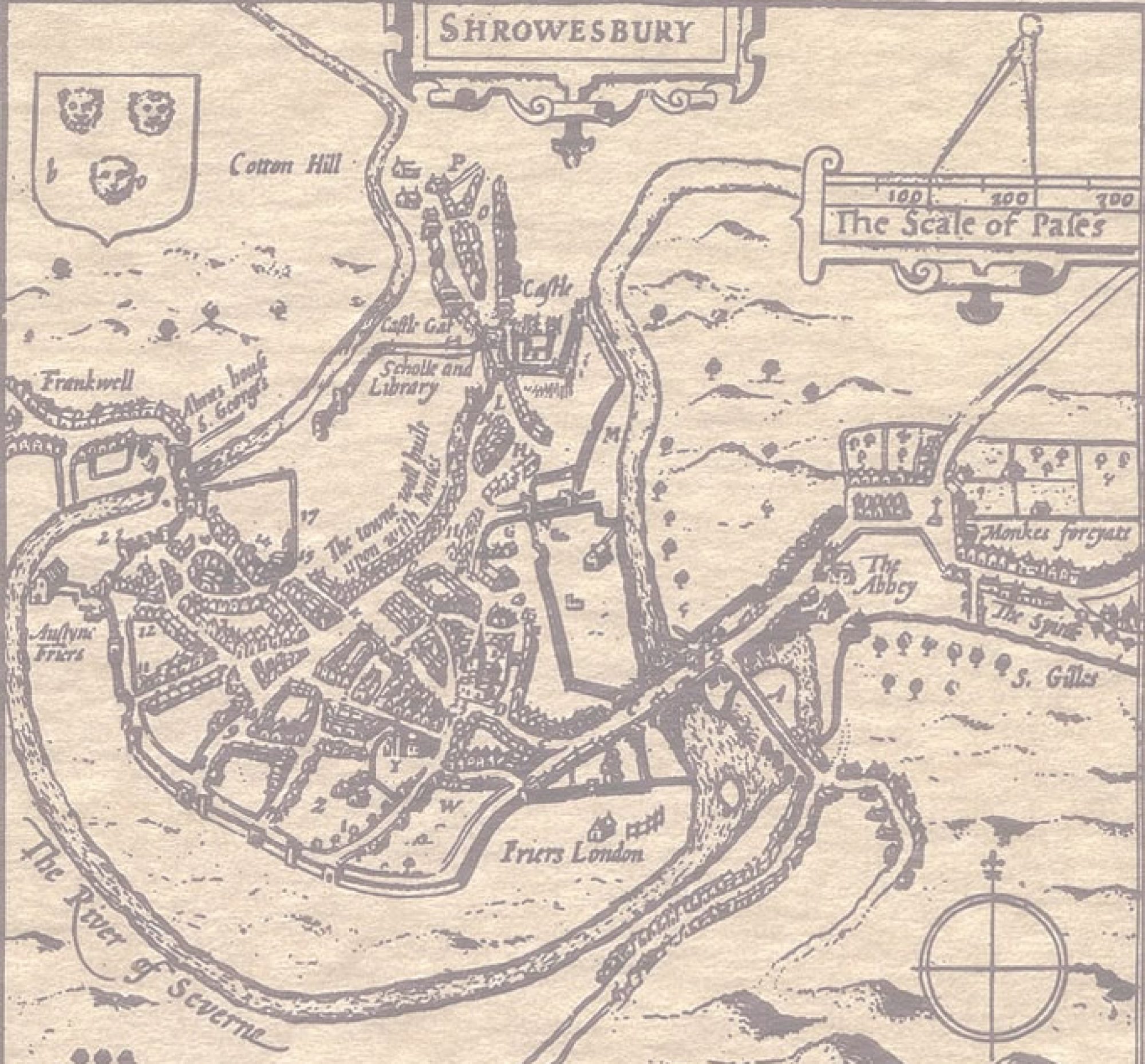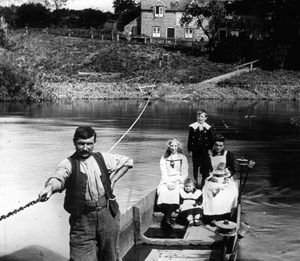
Monkmoor was granted to Shrewsbury Abbey soon after its foundation in 1087 by Helgot, Lord of the Manor of Uffington, and was probably named after a wood called Mora, which soon became corrupted to ‘moor’, and hence ‘Monkmoor’ [footnote 1]. The historic area of Monkmoor is roughly contained in the area between the loop of the River Severn to the west and north, Preston Street to the east and Abbey Foregate/London Road to the south. The area was crossed by two tracks leading to ferries – what is now Monkmoor Road, leading to a ferry to Uffington, and Preston Street, with its ferry to Preston. These ferries lasted into the 20th century [footnote 2].
Monkmoor’s connection with the Abbey can be traced in some of its road names [footnote 3]. Land in the area of Abbot’s Road was personally owned by the Abbot of Shrewsbury. Gay Meadow was probably a monastic park attached to the Abbey. Holywell Street (the first part of Underdale Road) recalls the Holy Well, or well of St Winifrede, situated somewhere near the modern railway bridge. This well was considered to have curative properties. A second well or spring is remembered in Flagwall, off Crowmere Road, which is a corruption of Flegwell – a well in a marshy place overgrown with flags (irises) – which was leased to the Dominican canons. Another religious group is remembered in the name Freer Meadow, a corruption of Friar’s Meadow.
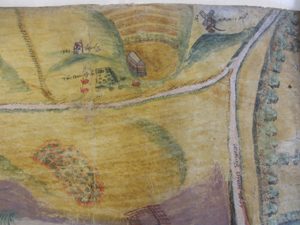
Much of the area was wooded, but some was also used for agriculture. Dymen’s Meadow, Coller Meadow and Potter’s Meadow (all off Crowmere Road) are probably named after people or their occupations. Cromer Croft or Cromacre was probably named after a rookery, and became corrupted to Crowmoor or Crowmere. Arable farming is recalled by Barleyfield, and near this is Connyger Crescent, a reminder of the conyger, or warren, for rabbits (originally coneys), farmed there for the monks’ table. Another ancient field name is now known as Judith Butts, but was originally Judas Butts. The term ‘Butts’ in place names is often connected to archery, but in this case it may just signify a strip of land abutting at right angles onto the boundary of another.
Whitehall
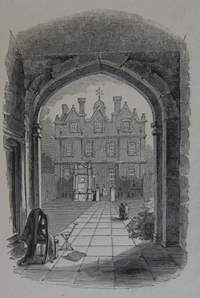
Whitehall Street was originally a track leading from the northeast corner of the Abbey to Whitehall – a grand mansion built between 1578 and 1582 by Richard Prynce (c1520’s – 1598) [footnote 4]. Prynce was born in Shrewsbury, the son of John Prynce, a ‘shoemaker’ (more likely a leather dealer). Richard Prynce became a lawyer and MP for both Ludlow and Bridgnorth at the same time. He built an extensive and lucrative legal practice, and also married into the Shropshire gentry, factors which helped him to become one of the richest men in the kingdom outside the aristocracy. Whitehall was called by that name because the walls, built with stone taken from the old Abbey buildings, were whitewashed until the nineteenth century.
Cherry Orchard
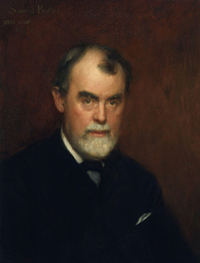
After three generations, the male Prynce line died out, and the Whitehall estate was inherited by the Earls of Tankerville [footnote 5]. In 1835 the house, with 28 acres of land, was sold to Dr Samuel Butler, then headmaster of Shrewsbury School [footnote 6]. When he died in 1839, he left the estate to his grandson, also Samuel (1835-1902), on condition that he allowed his father and aunt to live there until their deaths. In 1857, Samuel Butler junior, by then an impecunious author, sold just the mansion to his cousin, and in 1887, when his father died, he was able to develop the rest of the Whitehall estate on what had been a cherry orchard in the time of the Earls of Tankerville [footnote 7]. Butler named Bishop Street after his grandfather, who had been Bishop of Lichfield. He christened Canon Street after his father – Canon Thomas Butler; Clifford Street after his London home – Clifford’s Inn; and Alfred Street after his valet – Alfred Cathie [footnote 8].
The Racecourse
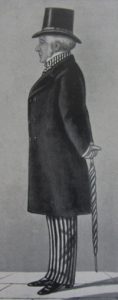
It is a bit confusing that there is a Racecourse Lane in Copthorne and a Racecourse Avenue and Crescent in Monkmoor, but no sign now of a racecourse in either area. The first racecourse in Shrewsbury was probably an informal one on Kingsland, dating from around 1717 [footnote 9]. Later there was one in Copthorne that was owned by the Mytton family, but was sold when ‘Mad Jack’ Mytton became bankrupt in 1825, and the new owners did not want to continue the racing. In 1832 a permanent new Racecourse was created to the east of Monkmoor Road – this was one mile and 185 yards in length. Initially the race meetings were not very successful, but this began to change when John Frail (1804-79) took over the management of the course in 1843. Frail was trained as a barber, but at an early age he joined the Tory party, and became election agent in 1830. Fighting elections in those days usually involved bribery, at which Frail was an expert, and he was one of three persons, known locally as ‘The Knot’, who ran the Conservative party behind the scenes.
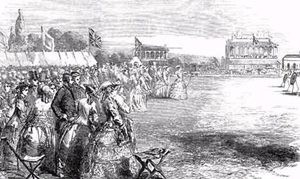
When he took over as clerk to the racecourse, he applied his considerable energy and connections in the Tory party to steadily build up the success of the autumn race meeting. At his first meeting only 9 horses were entered; at the last before he died there were over 200. Frail had a financial interest in several horses, though none ever ran in his name. As he was the handicapper, he probably handicapped his horses favourably, and there were also stories of jockeys being told not to win. Legally or illegally, Frail became a rich man. In later life he sought greater respectability, and he was elected mayor in 1878, but died in office. His obituary notice in 1879 described him as ‘a familiar figure, with his curly grey locks, his hat with curved brim, his scrupulously neat attire, and his sound sense, and stories full of dry humour dolled forth in measured tones that will be much missed in the racing season’.
Monkmoor Racecourse did not long survive Frail’s death, and it was eventually bought by the Council in 1925 for £8,500. By 1937 they had built 300 houses on the land, as well as 100 more being put up by private developers. The only part of the Racecourse that remains undeveloped is the Monkmoor recreation ground.
Footnotes
[1] Owen and Blakeway, A History of Shrewsbury, Vol. II, 1825, p.17
[2] Tony Carr, Shrewsbury, a Pictorial History, Phillimore, 1994, 162
[3] Information in this section from John L Hobbs, Shrewsbury Street Names, Wildings, 1954
[4] http://www.discovershropshire.org.uk/html/search/verb/GetRecord/theme:20061017142219, accessed 1.7.2014
[5] CW Radclyffe, Memorials of Shrewsbury School, 1843, SA fD35.7
[6] Barrie Trinder, Beyond the Bridges, Phillimore, 2006, p.64
[7] Hobbs, op. cit
[8] M Joyce Lee, ‘Cherry Orchard, the growth of a Victorian suburb’, Shropshire Magazine, September 1980, pp. 42-44, and October 1980, pp. 41-43; Joyce Lee, ‘Cherry Orchard, the growth of a Victorian suburb’, in Victorian Shrewsbury, Shropshire Libraries, 1984, p.118
[9] J Merville, ‘Ghosts of the Turf’, Shropshire Magazine, December 1966, p.49
